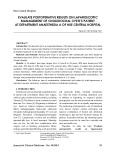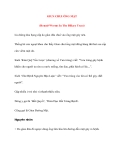
Biliary tract
-
Choledochal cyst is a congenital disease of the abnormaly anatomy of inside and outside bile ducts in the liver. Laparoscopic treatment of choledochal cyst is the main treatment method. The quality of treatment depends on the follow-up care of patient after surgery.
 5p
5p  vinatisu
vinatisu
 29-08-2024
29-08-2024
 4
4
 3
3
 Download
Download
-
Là chứng đau bụng cấp do giun đũa chui vào ống mật gây nên. Thống kê của ngoại khoa cho thấy Giun chui ống mật đứng hàng thứ hai sau cấp cứu viêm ruột dư. Sách ‘Kim Quỹ Yếu Lược’ (chương về Vưu trùng) viết: “Vưu trùng gây bệnh khiến cho người ta nôn ra nước miếng, tim đau, phát bệnh có lúc...”.
 14p
14p  abcdef_39
abcdef_39
 21-10-2011
21-10-2011
 104
104
 6
6
 Download
Download
-
CÁC BIỂU HIỆN THÔNG THƯỜNG CỦA BỆNH ĐƯỜNG MẬT? Bệnh sỏi mật (cholelithiasis) là sự hiện diện của sỏi (gallstones) trong túi mật nhưng không có chứng cớ nhiễm trùng. Trong số những người trưởng thành, 8% đàn ông và 17% phụ nữ có sỏi mật, nhưng tỷ lệ gia tăng với tuổi tác. Cơn đau quặn gan (biliary colic) là cơn đau ở hạ sườn phải hay thượng vị, đôi khi lan lên vai hay xuống bả vai phải. Cơn dau thường kéo dài dưới 6 giờ, xảy ra sau một bữa ăn nhiều chất mỡ, và được...
 12p
12p  thiuyen111
thiuyen111
 11-04-2011
11-04-2011
 121
121
 11
11
 Download
Download
-
VAI TRÒ CỦA CHUP CỘNG HƯỞNG TỪ HẠT NHÂN ĐƯỜNG MẬT-TỤY (MAGNETIC RESONANCE CHOLANGIOPANCREAOGRAPHY) TRONG CHẨN ĐOÁN SỎI ỐNG MẬT CHỦ? Chụp cộng hưởng từ hạt nhân đường mật-tụy (magnetic resonance cholangiopancreatography) có mức độ nhạy cảm ( 90% ) và đặc hiệu ( 97%) cao trong chẩn đoán sỏi ống mật chủ, khi so sánh với chụp mật-tụy ngược dòng qua nội soi đường tiêu hóa ( ERCP : endoscopic retrograde cholangiopancreatography). Đây là một thăm dò hữu ích để chẩn đoán không xâm nhập sỏi ống mật chủ và có thể là thăm dò lựa chọn...
 12p
12p  thiuyen111
thiuyen111
 11-04-2011
11-04-2011
 86
86
 10
10
 Download
Download
-
Fever is the most common presenting sign of liver abscess. Some patients, particularly those with associated disease of the biliary tract, have symptoms and signs localized to the right upper quadrant, including pain, guarding, punch tenderness, and even rebound tenderness. Nonspecific symptoms, such as chills, anorexia, weight loss, nausea, and vomiting, may also develop. Only 50% of patients with liver abscesses, however, have hepatomegaly, right-upper-quadrant tenderness, or jaundice; thus, half of patients have no symptoms or signs to direct attention to the liver.
 5p
5p  thanhongan
thanhongan
 07-12-2010
07-12-2010
 55
55
 3
3
 Download
Download
-
Palliation Surgery is employed in a number of ways for supportive care: insertion of central venous catheters, control of pleural and pericardial effusions and ascites, caval interruption for recurrent pulmonary emboli, stabilization of cancerweakened weight-bearing bones, and control of hemorrhage, among others. Surgical bypass of gastrointestinal, urinary tract, or biliary tree obstruction can alleviate symptoms and prolong survival. Surgical procedures may provide relief of otherwise intractable pain or reverse neurologic dysfunction (cord decompression).
 5p
5p  konheokonmummim
konheokonmummim
 03-12-2010
03-12-2010
 89
89
 4
4
 Download
Download
-
Trace Mineral Intake Zinc 2.5–4 mg/d, an additional 10–15 mg/d per L of stool or ileostomy output Copper 0.5–1.5 mg/d, possibility of retention in biliary tract obstruction Manganese 0.1–0.
 6p
6p  konheokonmummim
konheokonmummim
 03-12-2010
03-12-2010
 77
77
 6
6
 Download
Download
-
Extrarenal Nonrenal causes of hypovolemia include fluid loss from the gastrointestinal tract, skin, and respiratory system and third-space accumulations (burns, pancreatitis, peritonitis). Approximately 9 L of fluid enters the gastrointestinal tract daily, 2 L by ingestion and 7 L by secretion. Almost 98% of this volume is reabsorbed so that fecal fluid loss is only 100–200 mL/d. Impaired gastrointestinal reabsorption or enhanced secretion leads to volume depletion.
 5p
5p  ongxaemnumber1
ongxaemnumber1
 29-11-2010
29-11-2010
 73
73
 5
5
 Download
Download
-
The liver is the most important organ in which drugs are structurally altered. Some of the resulting metabolites may be biologically inactive, some active and some toxic (see Chapter 7).The liver is exposed to drugs in higher concentrations than are most organs because most are administered orally and are absorbed from the gastrointestinal tract.Thus the whole dose must pass through the liver to reach the systemic circulation.
 10p
10p  bigbaby87
bigbaby87
 03-09-2010
03-09-2010
 916
916
 10
10
 Download
Download
CHỦ ĐỀ BẠN MUỐN TÌM





















